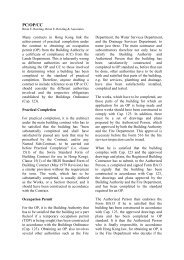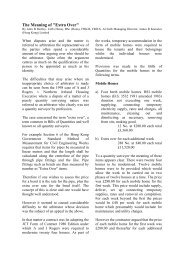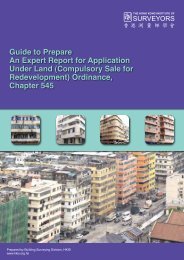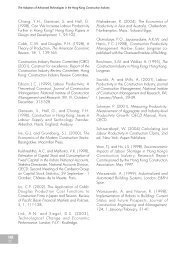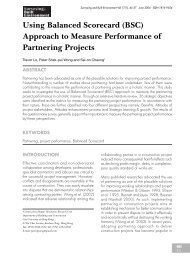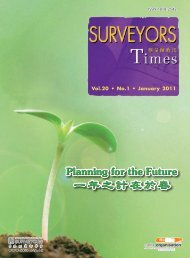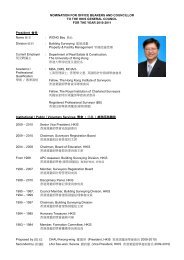Surveying & Built Environment Vol. 22 Issue 1 (December 2012)
Surveying & Built Environment Vol. 22 Issue 1 (December 2012)
Surveying & Built Environment Vol. 22 Issue 1 (December 2012)
Create successful ePaper yourself
Turn your PDF publications into a flip-book with our unique Google optimized e-Paper software.
SBE<br />
66<br />
Modelling Gaseous Emissions from Energy Consumption during Building Life Cycle<br />
Major gaseous emissions of the<br />
manufacture of building material<br />
element<br />
Gaseous emissions caused by<br />
using energy during the process of<br />
manufacturing construction materials<br />
are mainly the result of stationery<br />
sources. These include fuel combustion<br />
and electricity use for various<br />
appliances and plant. The major<br />
construction materials are cement,<br />
aggregate, sand, steel, aluminium,<br />
glass, and timber (Zhang, 2002).<br />
Major gaseous emissions during the<br />
transportation of building material<br />
Gaseous emissions from using<br />
energy during construction material<br />
transportation are mainly the results<br />
of the direct (internal combustion<br />
engines) or indirect (electric motors)<br />
combustion of fuel by delivery, moving<br />
and hoisting vehicles. For example a<br />
tower crane is normally one of the most<br />
significant and common sources in<br />
moving building material and is driven<br />
by powerful electric motors consuming<br />
up to 65KW.<br />
Major gaseous emissions during<br />
construction<br />
Gaseous emissions from energy use<br />
during construction are mainly the<br />
result of the direct or indirect fuel<br />
consumption of fixed and mobile<br />
construction equipment from major<br />
plant like tower cranes to individual<br />
operator power tools. Construction<br />
is normally the most important stage<br />
during the life cycle process, as poor<br />
construction can lead to poor operation<br />
and high maintenance cost, and may<br />
even shorten the total life cycle.<br />
Major gaseous emissions during<br />
operation<br />
Gaseous emissions from energy use<br />
during building operation are mainly<br />
the results of direct and indirect fossil<br />
fuel consumption for air-conditioning,<br />
lighting, cooking, washing, and<br />
operating various electrical equipment<br />
like pumps, elevator motors, office<br />
or home fitout, etc. This depends on<br />
how the end-users use facilities and<br />
equipment.<br />
Major gaseous emissions during<br />
maintenance and repair<br />
Gaseous emissions from energy use<br />
to undertake maintenance and repair<br />
works are partly the result of materials<br />
manufacturing and transportation for<br />
maintenance and repair projects, and<br />
partly the result of changes to energy<br />
use caused by maintenance and repair<br />
work in concurrent building operation.<br />
Major gaseous emissions during<br />
demolition<br />
Gaseous emissions from energy use<br />
during building demolition are mainly<br />
the result of fuel requirements for<br />
demolition works. During this phase<br />
there is also the significant risk of high<br />
PM emission.<br />
Major gaseous emissions during<br />
disposal of construction waste<br />
Gaseous emissions from energy use in<br />
treating and recycling for demolition<br />
waste are mainly caused by fuel<br />
consumption for transport of waste and<br />
subsequent handling. Proper treatment<br />
and recycling of demolition waste can,<br />
other things equal, result in reducing<br />
social costs by extending the limited<br />
space for landfills or discover new areas<br />
for landfills for the disposal in the long<br />
term.




